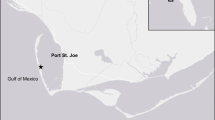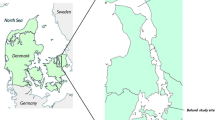Abstract
The effect of water depth on bacterial biomass and their ability to synthesise DNA, by measuring their rate of [3H]-thymidine incorporation, was investigated in the northeast Atlantic at three sites of varying water depth (1100–3580 m) and sediment characteristics. Thymidine incorporation rates (y) in surficial sediments varied between 0.028 and 1.44 pmol h−1 g−1 and showed an exponential relationship with depth (x) according to the equation y= 2.05e−0.0011x (r=0.9830 for n=7, P<0.001). However, this relationship failed when a layer of phytodetritus was found overlying the surface sediment and [3H]-thymidine incorporation rates increased by 80–339%. In contrast, bacterial numbers varied between 1.09 and 11.96 × 108 cells g−1 (dry weight) and showed no significant relationships with water depth or sediment POC/TN content. Significant exponential relationships were also found between water depth (x) and the POC (y 1) and total nitrogen (TN, y 2) content of surficial sediments according to the following equations: where y 1 = 719e−0.0003x (r=0.8700 for n=9, P<0.01) and y 2 = 76e−0.0002x(r=0.7582 for n=9 P<0.02). These relationships were irrespective of the presence or absence of an overlying layer of phytodetritus. This suggests that the POC and TN content of these surficial deep sea sediments is directly related to the flux of material through the water column, which significantly impacts bacterial production.
Similar content being viewed by others
References
Barnett, P. R., J. Watson & D. Connelly, 1984. A multiple corer for taking virtually undisturbed samples from the shelf, bathyal and abyssal sediments. Oceanol. Acta 7: 399–408.
Deming, J. W., 1997. Unusual or extreme high pressure marine environments. In Hurst, C. J., G. R. Knudsen, M. J. McInerney, L. D. Stetzenbach & M. V. Walter (eds), Manula of Environmental Microbiology. ASM Press, Washington D.C: 366–376.
Deming, J.W. & J. A. Baross, 1993. The early diagenesis of organic matter: Bacterial activity. In Engel, M. H. & S. A. Macko (eds), Organic Geochemistry. Plenum Press 6, New York: 119–144.
Deming, J. W. & P. L. Yager, 1992. Natural bacterial assemblages in deep sea sediments: Towards a global view. In Rowe, G. T. & V. Pariente (eds), Deep Sea Food Chains and the Global Carbon Cycle. Kluwer Academic Publishers, Dordrecht, The Netherlands: 11–27.
Epstein, S. S., 1997. Microbial food webs in marine sediments. I. Trophic interactions and grazing rates in two tidal flat communities. Microbiol. Ecol 34: 188–189.
Findlay, S., 1993. Thymidine incorporation into DNA as an estimate of sediment bacterial production. In Kemp, P. F., B. F. Sherr, E. B. Sherr & J. J. Cole (eds), Handbook of Methods in Aquatic Microbial Ecology. CRC Press, Inc., Boca Raton, Florida: 505–508.
Fukuda, R., H. Ogawa., T. Nagata & I. Koike, 1998. Direct determination of carbon and nitrogen contents of natural bacterial assemblages in marine environments. Apl. envir. Microbiol. 64: 3352–3358.
Goldman, J. C., D. A. Caron & M. R. Dennett, 1987. Regulation of gross efficiency and ammonium regeneration in bacteria by substrate C:N ratio. Limnol. Oceanogr. 32: 1239–1252.
Gooday, A. J. & C. M. Turley, 1990. Responses by benthic organisms to inputs of organic material to the ocean floor: a review. Phil. Trans. r. Soc., Lond. A. 331: 119–138.
Keil, R. G., D. B Montlucon, F. G. Prahl & J. I. Hedges, 1994 Sorptive preservation of labile organic matter in marine sediments. Nature 370: 549–552.
Lampitt, R. S., 1985. Evidence for the seasonal deposition of detritus to the deep sea floor and its subsequent resuspension. Deep Sea Res. 32: 885–897.
Lampitt, R. S., P. P Netwon, T. D. Jickells, T. D. Thompson & P. King, 2000. Near-bottom particle flux in the abyssal Northeast Atlantic. Deep Sea Res. 47: 9–11.
Lochte, K., 1992. Bacterial standing stock and consumption of organic carbon in the benthic boundary layer of the abyssal North Atlantic. In Rowe, G. T. & V. Pariente (eds), Deep Sea Food Chains and the Global Carbon Cycle. NATO-ASI Series C Volume 360, Mathematical and Physical Sciences, Kluwer Academic Publishers, Dordrecht/Boston/London: 1–10.
Lochte, K. & C. M. Turley, 1988. Bacteria and cyanobacteria associated with phytodetritus in the deep sea. Nature 333: 67–69.
Newton, P. P., R. S. Lampitt, T. D. Jickells, P. King & C. Boule, 1994. Temporal and spatial variability of biogenic particle fluxes during the JGOFS northeast Atlantic process study at 47º N, 20º W. Deep Sea Res. I. 41: 1617–1642.
Pfannkuche, O., 1993. Benthic response to the sedimentation of particulate organic matter at the BIOTRANS station 47º N, 20º W. Deep Sea Res. II. 40: 135–150.
Rice, A. L., 1983. Thomas Henry Huxley and the strange case of Bathybius haeckelii: a possible alternative explanation. Arch. nat. Hist. II. 2: 169–180.
Rice, A. L., D. S. M. Billet, J. Fry, A. W. G. Fry, R. S. Lampitt, R. F. C. Mantoura & R. J. Morris, 1986. Seasonal deposition of phytodetritus to the deep sea floor. Proc. r. Soc. Edin. B. 88: 265–279.
Richards, K. J., 1990. Physical processes in the benthic boundary layer. Phil. Trans. r. Soc., Lond. A. 331: 3–13.
Sibuet, M., 1987. Structures des peuplements benthique en relation avec les conditions trophique en milieu abyssal dans l'ocJan Atlantique. ThPse de Doctorat d'Etat Js Sciences Naturelles. UniversitJ Pierre et Marie Curie, France.
Sibuet, M., C. Monniot, D. DesbruyPres, A. Dinet, A. Khripounoff, A. Rowe & M. Segonzac, 1984. Peuplements benthique et caractJristiques trophique du milieu dans la plaine abyssale de Demerara dans l'Ocean Atlantique. Oceanol. Acta 7: 345–358.
Suess, E. & X. Le Pichon, 1994. The deep sea floor as a changing environment. Report of the ECOPS Euroconference, Kiel, GEOMAR publication: 48 pp.
Thiel, H., O. Pfannkuche, G. Schriever, K. Lochte, A. J. Gooday, C. H. Hemleben, R. F. C. Mantoura, C. M. Turley, J. W. Patching & F. Riemann, 1988/89. Phytodetritus on the deep sea floor in a central oceanic region of the northeast Atlantic. Biol. Oceanogr. 6: 203–239.
Thomsen, L., 1999. Processes in the benthic boundary layer at continental margins and their implications for the benthic carbon cycle. J. Sea Res. 41: 73–86.
Thorn, P. M. & R. M. Ventullo, 1988. Measurement of bacterial growth rates in subsurface sediments using the incorporation of tritiated thymidine into DNA. Microbiol. Ecol. 16: 3–16.
Touratier, F., L. Legendre & A. VJzina, 1999. Model of bacterial growth influenced by substrate C:N ratio and concentration. Aquat. Microbiol. Ecol. 19: 105–118.
Tseytlin, V. B., 1987. Detritus flux to the ocean bed and benthic biomass. Oceanologia 27: 98–101.
Turley, C. M., 1993. Direct estimates of bacterial numbers in seawater samples without incurring cell loss due to sample storage. In Kemp, P. F., B. F. Sherr, E. B. Sherr & J. J. Cole (eds), Handbook of Methods in Aquatic Microbial Ecology. CRC Press, Inc., Boca Raton, Florida: 143–147.
Turley, C. M. & D. J. Hughes, 1994. The effect of storage temperature on bacterial cell loss in preserved seawater samples. J. mar. biol. Ass. U.K. 74: 259–262.
Turley, C. M. & D. J. Hughes, 1992. Effects of storage on direct estimates of bacterial numbers of preserved seawater samples. Deep Sea Res. 39: 375–394.
Turley, C. M. & K. Lochte, 1990. Microbial response to the input of fresh detritus to the deep sea bed. Palaeogeography, Palaeoclimatology, Palaeoecology (Global and Planetary change section) 89: 3–23.
Turley, C. M. & P. J. Mackie, 1995. Bacterial and cyanobacterial flux to the deep NE Atlantic on sedimenting particles. Deep Sea Res. I.42: 1453–1474.
Turley, C. M., K. Lochte & R. S. Lampitt, 1995. Transformations of biogenic particles during sedimentation in the northeastern Atlantic. Phil. Trans. r. Soc., Lond. B. 348: 179–189.
Verardo, D. J., P. N. Froelich & A. McIntyre, 1990. Determination of organic carbon and nitrogen in marine sediments using the Carlo Erba NA-1500 Analyser. Deep Sea Res. II. 37: 157–165.
Rights and permissions
About this article
Cite this article
Dixon, J.L., Turley, C.M. The effect of water depth on bacterial numbers, thymidine incorporation rates and C:N ratios in northeast Atlantic surficial sediments. Hydrobiologia 440, 217–225 (2000). https://doi.org/10.1023/A:1004127312756
Issue Date:
DOI: https://doi.org/10.1023/A:1004127312756




